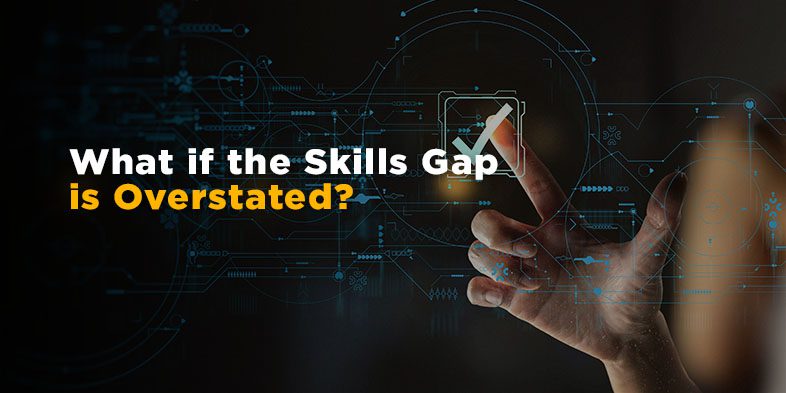What if the Skills Gap is Overstated?


As part of Solutions Review’s Contributed Content Series—a collection of contributed articles written by our enterprise tech thought leader community—Danny Abdo, the Chief Operations Officer at Skillable, asks if the industry is looking at the skills gap all wrong and might be overestimating its scale.
 Skills gap estimates state that around 85 million jobs will be unfilled globally by 2030, costing the global economy $8.5 trillion in potentially lost revenue. But like all estimates, this figure is based on what we know and assume. What if we’re looking at the skills gap all wrong and overestimating its scale? We believe there’s a smaller skills gap than what actually exists.
Skills gap estimates state that around 85 million jobs will be unfilled globally by 2030, costing the global economy $8.5 trillion in potentially lost revenue. But like all estimates, this figure is based on what we know and assume. What if we’re looking at the skills gap all wrong and overestimating its scale? We believe there’s a smaller skills gap than what actually exists.
Our current measures are based on traditional hiring methods going out of fashion. In the past, a hiring manager who needed to fill a vacancy would look at a narrow set of candidates who could prove they could succeed in that role. How? By showing they had done the job before. If you needed an operations manager, you’d look for someone who had worked for several years in operations roles.
Roles Are an Easy Default
The pool of skills and talent will massively expand if you consider those who have developed skills outside of just performing the job or have transferable skills from other jobs. However, this population is not making it through existing hiring practices. Try as we might, with skills-based hiring and broadening job descriptions, we default back to previous roles and years of experience as the de facto way of assessing someone’s suitability for a vacancy. It’s almost laughable, as the many memes on Reddit show disgruntled job seekers poking fun at employers “needing ten years of experience before the age of 22”.
Skills Are a Leap of Faith
There are two main reasons behind this stubbornness. Firstly, shifting solely to a skills-based hiring model takes a tremendous leap of faith in trusting that those skills reflect a candidate’s competency and potential. In fact, “validating skills, competencies, and references” is the top obstacle cited by business leaders who are attempting a skills-based hiring approach.
This doesn’t just rule out those without the requisite years of experience but also candidates from non-traditional academic backgrounds. Although 80 percent of leaders want to prioritize skills over degrees, 52 percent still default to degree programs because it feels less risky.
The Cost of a New Hire
Secondly, onboarding a new employee is costly, so adding a need for more upskilling or the potential for a hire to be unsuitable for the role is a risk many employers don’t want to take, especially in the current economic climate. Indeed, employer confidence in finding the right fit for their open roles continues to decline. Everyone is looking for the perfect person, but like every good relationship coach will tell you, that person doesn’t exist.
Skills Pressures Are Breaking Traditional Hiring
The skills gap is widening across all industries in multiple ways. The brain drain is causing experienced talent to retire, taking their decades of knowledge with them. Others are leaving permanent employment to join the contingent workforce. Then you have perception issues with industries like oil and gas and manufacturing, causing younger generations to pass on those job opportunities. The skills mismatch means potential candidates don’t have the necessary skills for in-demand roles.
Finally, urgent skill needs in digital, cybersecurity, and green industries are accelerating the skills gap for those specific hard skills. CIOs report significant challenges with filling cybersecurity, data science, AI, machine learning, and software engineering roles. Many candidates for these positions don’t have years of experience to prove they can do well in a role.
Not to mention, roles are being created today that didn’t exist before. Very soon, we’ll be seeking out algorithm-bias auditors, robot-human team managers, smart building designers, and cryptocurrency advisors. Just like how the internet created new roles in social media, email, and blogging, nobody alive today can prove their competency in these positions by experience alone. By necessity, hiring managers will have to look outside of their narrow definition of what makes someone suitable for a role.
That is a good thing because when we shift away from solely looking for a marketing manager to replace another marketing manager, we level the playing field for those looking for a career change, who want to take advantage of emerging career paths, and who may have a non-traditional route into the industry. So, how can we build the same confidence in hiring managers who are looking beyond role experiences for the best candidates?
The Closest Thing to Role-Based Experience
The answer lies in hands-on learning and skill validation. It’s the closest you can get to proving your skill without doing the job. Hence, some employers are turning to this learning to upskill for future role needs. For example, a U.S.-based healthcare provider needed nursing assistants but couldn’t find suitable candidates through job postings. It partnered with a local technical college on an end-to-end clinical training program that upskilled 200 new nursing assistants with the right skills and qualifications.
Employers are picking up the gauntlet—Deloitte has its leadership shadowing program, Unilever has its Future Leaders program, and Amazon has its Technical Academy. These are steps in the right direction. Yet, these programs aren’t easily scalable; they take a lot of effort and investment to set up and, therefore, tend to be limited in scope to specific groups (like high potentials) or roles (leadership, AI, and data science).
Virtual labs and challenges offer a more scalable and inclusive method for the roles and skills that cannot be taught via stretch assignments and shadowing or for immediate skill needs that appear unexpectedly (like ChatGPT-related prompt engineering skills). With a virtual skills challenge, candidates can practice and apply their knowledge and skills in a safe environment and be tested to ensure they can complete specific tasks. This is as varied as stopping a DDoS attack, troubleshooting a customer service ticket, or completing a sales call. This kind of hands-on experience gives the validation needed for confident hiring, and it can scale to anyone, anywhere in the world.
It isn’t just hiring manager confidence that gets a boost. With nearly a third of workers lacking confidence in their ability to move into different roles and sectors, offering validation through challenges and simulations can show them that they are ready for a new position.
Time to Shift Our Perceptions
As we face more headlines about skills shortages and unrealized revenue, it’s time to shift perceptions away from simply hiring like-for-like in a role. Instead, broaden your horizons using hands-on learning to build the experience you need in your next hire.




















